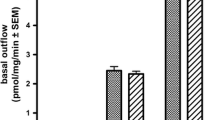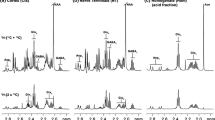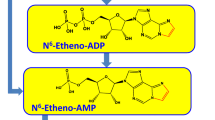Abstract
Both ouabain, 0.1 mM, and veratridine, 0.05 mM, increased the release of14C-labeled compounds from rat cortical slices prelabeled with14C-adenine and incubated in vitro. The increment in radioactivity released by both depolarizing agents was almost entirely a result of increases in adenosine, inosine, and hypoxanthine. However, the distribution of these three compounds in the ouabain-induced efflux (adenosine, 12%; inosine, 51%; hypoxanthine, 36%) contrasted with that evoked by veratridine (adenosine, 42%; inosine, 15%; hypoxanthine, 38%). Phenytoin significantly reduced the efflux of14C-labeled compounds produced by both ouabain and veratridine, but phenobarbital had no effect. The intracortical injection of adenosine, inosine, and hypoxanthine has been shown to induce epileptiform discharges in rats, and it is suggested that the inhibitory effect of phenytoin on the release of adenine derivatives may play a role in its antiepileptic action.
Similar content being viewed by others
References
Shimizu, H., Creveling, C.R., andDaly, J. (1970) Stimulated formation of adenosine 3′,5′-cyclic phosphate in cerebral cortex: Synergism between electrical activity and biogenic amines.Proc. Nat. Acad. Sci. U.S.A. 65, 1033–1040.
Pull, I., andMcIlwain, H. (1972) Metabolism of [14C] adenine and derivatives by cerebral tissues, superfused and electrically stimulated.Biochem. J. 126, 965–973.
Bignami, A., andPalladini, G. (1966) Experimentally produced cerebral status spongiosus and continuous pseudorhythmic electroencephalographic discharges with a membrane-ATPase inhibitor in the rat.Nature 209, 413, 414.
Lewin, E. (1970) Epileptogenic foci induced with ouabain.Electroencephalogr. Clin. Neurophysiol. 29, 402, 403.
Walker, J.E., Lewin, E., andMoffitt, B.C. (1974) Production of epileptiform discharges by application of agents which increase cyclic AMP levels in rat cortex. In: Harris, P., and Mawdsley, C. (eds.),Epilepsy: Proceedings of the Hans Berger Centenary Symposium, Churchill Livingstone, New York, pp. 30–36.
Lewin, E. (1976) Endogenously released adenine derivatives: A possible role in epileptogenesis.Trans. Am. Neurol. Assoc. (in press).
Shimizu, H., Daly, J.W., andCreveling, C.R. (1969) A radioisotopic method for measuring the formation of adenosine 3′,5′-cyclic monophosphate in incubated slices of brain.J. Neurochem. 16, 1609–1619.
Fiske, C.H. (1934) The nature of the depressor substance of the blood.Proc. Nat. Acad. Sci. U. S. A. 20, 25–27.
Shanes, A.M. (1958) Electrochemical aspects of physiological and pharmacological action in excitable cells: Part I. The resting cell and its alteration by extrinsic factors.Pharmacol. Rev. 10, 59–164.
Pull, I., andMcIlwain, H. (1973) Output of [14C] adenosine nucleotides and their derivatives from cerebral tissues: Tetrodotoxin-resistant and calcium ion-requiring components.Biochem. J. 136, 893–901.
Woodbury, D.M. (1969) Mechanisms of action of anticonvulsants. In: Jasper, H.H., Ward, A.A., and Pope, A. (eds.),Basic Mechanisms of the Epilepsies, Little, Brown and Company, Boston, pp. 647–681.
Author information
Authors and Affiliations
Rights and permissions
About this article
Cite this article
Lewin, E., Bleck, V. Release of14C-adenine derivatives from cerebral cortical slices: Effect of phenytoin and phenobarbital. Neurochem Res 1, 429–435 (1976). https://doi.org/10.1007/BF00966234
Accepted:
Issue Date:
DOI: https://doi.org/10.1007/BF00966234




